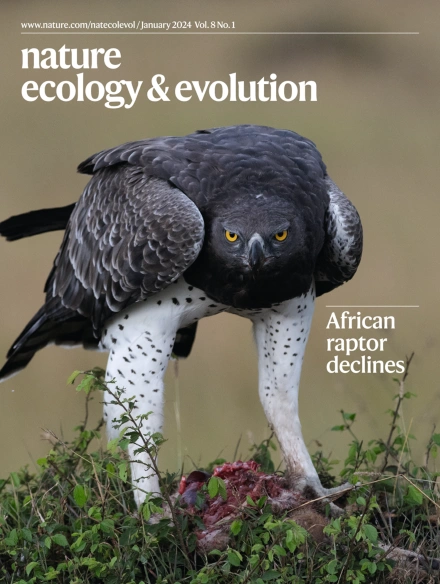水生食物网的复杂结构源于一些组装规则
IF 13.9
1区 生物学
Q1 ECOLOGY
引用次数: 0
摘要
食物网理论认为体型较大的捕食者通常会选择体型较大的猎物。这种异速生长规律不能解释水生食物网中相当一部分的营养联系。在这里,我们展示了食物网的限制导致了大小不一的捕食者公会,但它们专门捕食相同大小的猎物,这种专业公会的分布解释了大约一半的食物网结构。我们将517种远洋生物划分为5个捕食者功能群。它们大多遵循三种猎物选择策略:一个行会遵循异速生长规则,即较大的捕食者吃较大的猎物;两个行会的专家偏好比异速生长规则预测的更小或更大的猎物。这种独立于分类群或体型的非专业和专业行会的共存,指向了生态复杂性背后的结构原则。我们表明,该模式描述了全球18个水生生态系统中218个食物网中90%观察到的联系。这种模式可以与生态进化对猎物开发的限制联系起来,并为更有效的食物网模型提供了蓝图。本文章由计算机程序翻译,如有差异,请以英文原文为准。


The complex structure of aquatic food webs emerges from a few assembly rules
Food-web theory assumes that larger-bodied predators generally select larger prey. This allometric rule fails to explain a considerable fraction of trophic links in aquatic food webs. Here we show that food-web constraints result in guilds of predators that vary in size but have specialized on prey of the same size, and that the distribution of such specialist guilds explains about one-half of the food-web structure. We classified 517 pelagic species into five predator functional groups. Most of these follow three prey selection strategies: a guild following the allometric rule whereby larger predators eat larger prey and two guilds of specialists that prefer either smaller or larger prey than predicted by the allometric rule. Such coexistence of non-specialist and specialist guilds independent from taxa or body size points towards structural principles behind ecological complexity. We show that the pattern describes >90% of observed linkages in 218 food webs in 18 aquatic ecosystems worldwide. The pattern can be linked to eco-evolutionary constraints to prey exploitation and provides a blueprint for more effective food-web models. The structure of aquatic food webs does not fit standard allometric predictions. Here the authors explain the co-evolution of specialist and non-specialist predators in aquatic food webs and how this helps reconstruct food webs on the basis of a relatively small number of observations.
求助全文
通过发布文献求助,成功后即可免费获取论文全文。
去求助
来源期刊

Nature ecology & evolution
Agricultural and Biological Sciences-Ecology, Evolution, Behavior and Systematics
CiteScore
22.20
自引率
2.40%
发文量
282
期刊介绍:
Nature Ecology & Evolution is interested in the full spectrum of ecological and evolutionary biology, encompassing approaches at the molecular, organismal, population, community and ecosystem levels, as well as relevant parts of the social sciences. Nature Ecology & Evolution provides a place where all researchers and policymakers interested in all aspects of life's diversity can come together to learn about the most accomplished and significant advances in the field and to discuss topical issues. An online-only monthly journal, our broad scope ensures that the research published reaches the widest possible audience of scientists.
 求助内容:
求助内容: 应助结果提醒方式:
应助结果提醒方式:


